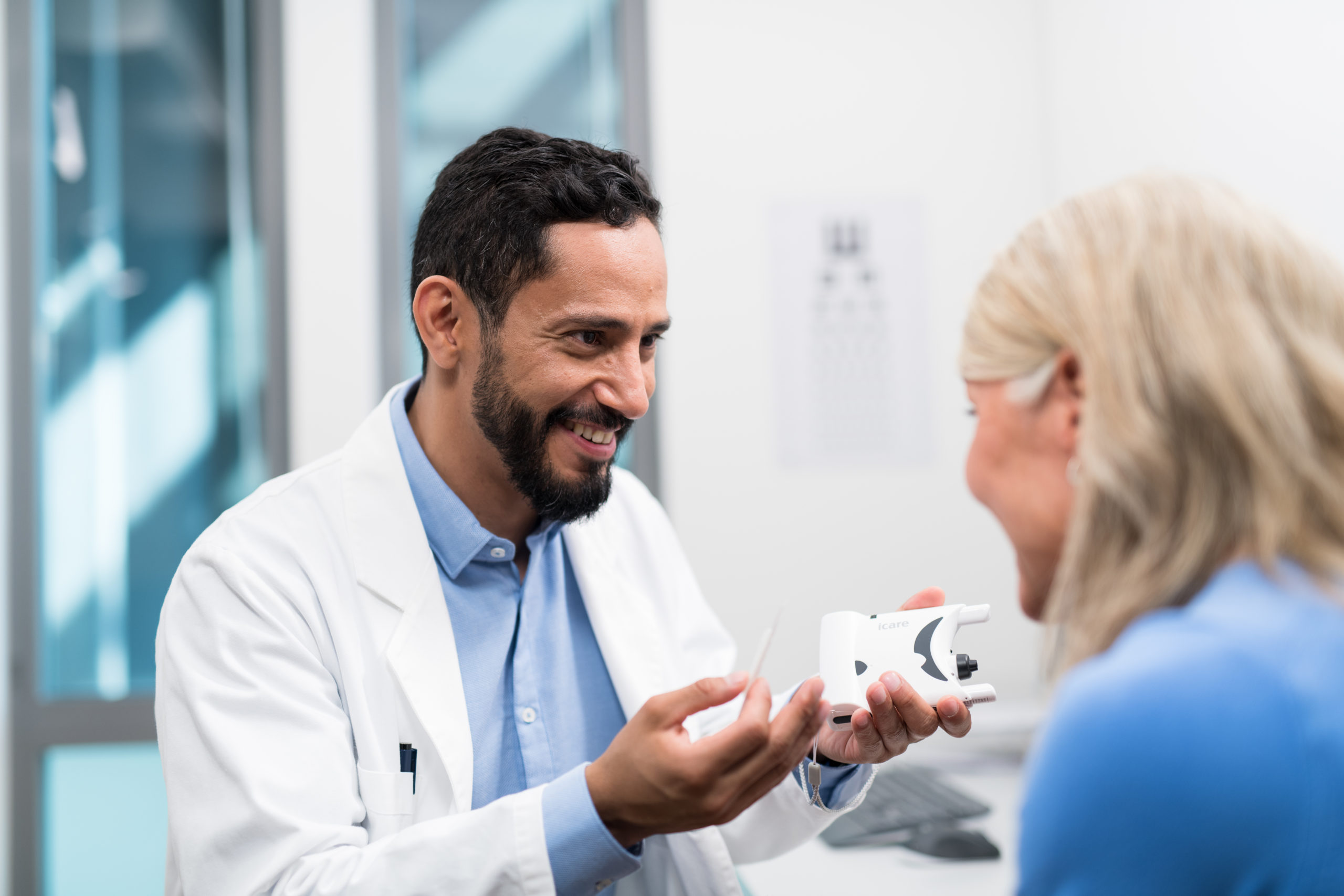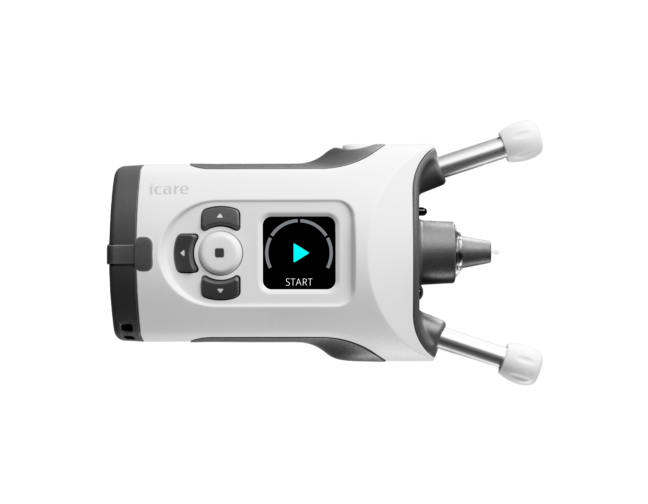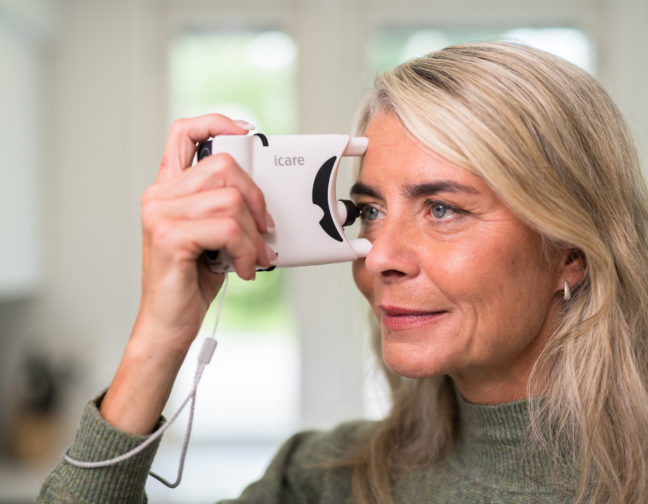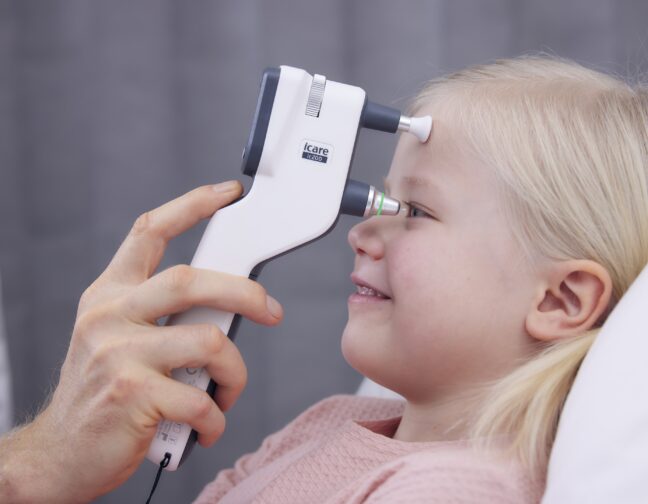Recent studies have highlighted that self-measuring of intraocular pressure (IOP) using the iCare HOME tonometer can be a reliable tool to aid clinical decision-making in glaucoma management.
Rebound self-tonometry has revolutionized glaucoma care over the last two decades. iCare HOME tonometers empower patients to take self-measurements and offer accurate real-world IOP data, that can support medical practitioners in their clinical decisions. Recent scientific publications attest to the convenience, reliability, and value of iCare HOME tonometers in modern-day glaucoma care.
The role of self-measurements in confirming the IOP-lowering effect of a medication regimen
Research by Mizohata et al1 observed that thanks to frequent IOP measurements, which can be done by the iCare HOME tonometer, even a small change in IOP can prove statistically significant.
The motivation for the study was that it is difficult to follow changes in IOP in glaucomatous eyes comprehensively because of the limited number of outpatient examinations. The findings were reported in a case of a 50-year-old patient with normal tension glaucoma (NTG) and a nasal step visual field defect in his right eye.
To evaluate the IOP-lowering effect of different medications, the patient was instructed to self-measure his IOP using the iCare HOME tonometer twice a day. The patient was treated using only 0.005% LAT ophthalmic solution in the first treatment period, then using a LAT and carteolol fixed combination (LCFC) for the second treatment period and finally using a brimonidine and brinzolamide fixed combination (BBFC) together with an LCFC ophthalmic solution.
Comparisons of the IOPs between the different treatment periods showed that the reductions in the IOP were significant. The authors concluded that by performing a large number of IOP measurements, even a small change in IOP of about 1-2 mmHg can be determined to be statistically significant and can confirm the significant IOP-lowering effect of a specific medication regimen.
Frequent measurements for more comprehensive data: The study cites research to point out that while Goldmann Applanation Tonometry (GAT) is the most widely accepted method of measuring IOP2, it’s not the most convenient or time efficient.
To measure IOP by GAT, patients need to come to the clinic, be topically anesthetized, and have the IOP measured by a trained doctor or technician. In addition, to follow the course of the IOP changes accurately, frequent measurements need to be made in the clinic.
The iCare HOME tonometer overcomes these problems by enabling measurements without anesthesia — patients can be trained to record their IOPs accurately and safely3 and self-measurements can be performed by the patient daily to obtain a more detailed evaluation of the diurnal and daily fluctuations in the IOP4-7.
Measuring IOP at home can reveal patterns not apparent during in-clinic measurements
A study by A.M. Levin et al 8 describes 12 cases (18 eyes) of patients who underwent IOP-lowering interventions for primary or secondary glaucoma. They used iCare HOME devices to measure their IOP before and after the interventions to gain a better understanding of individual diurnal and nocturnal IOP fluctuations.
The study found that home tonometry can reveal patterns that are not apparent during in-clinic measurements, particularly when in-clinic IOP appears stable. Higher peaks and greater fluctuations have been identified by home IOP monitoring outside of clinic hours than by in-clinic tonometry.9
Prior studies have not extensively explored the utility of home tonometry in monitoring response to interventions. The authors noted that postoperatively, home IOP monitoring may help the surgeon gain a better understanding of the impact of the procedure more quickly than would otherwise be obtained by consecutive clinic visits.
Through reliable data, home tonometry offered a better understanding of the response to the intervention, which was sometimes sub-optimal and required further intervention at early time points. The authors point out that many other studies have demonstrated that iCare HOME measurements are accurate and reproducible.9-12
Offering convenience to patients and professionals: The study highlighted that home monitoring has the potential to reduce the number of in-person clinic visits scheduled solely for IOP monitoring, which could be an inconvenience for the patient as well as potentially delay earlier intervention.
The cases in the study demonstrate how home tonometry can augment clinical decision-making and evaluate the impact of IOP-lowering interventions. The authors propose that home tonometry has the potential to be a useful tool that can positively impact the care of glaucoma patients.
Self-tonometry with iCare HOME — a valuable method to complement traditional glaucoma care
A doctoral thesis by Laurence Quérat13 that studied the self-monitoring of intraocular pressure and its clinical application attests to the significant role a device like the iCare HOME tonometer could play in glaucoma care.
The thesis included five papers:
- Paper I: Self-tonometry as a complement in the investigation of glaucoma patients 14
- Paper II: Monitoring daily intraocular pressure fluctuations with self-tonometry in healthy subjects. 15
- Paper III: Home vs. Goldmann applanation tonometry: Agreement of methods and comparison of inter-observer variation at a tertiary eye centre. 16
- Paper IV: Impact of self-tonometry on glaucoma treatment decision. 17
The findings highlighted the feasibility and reliability of self-tonometry, the usefulness of monitoring different IOP patterns from day to day, and the presence of IOP peaks outside office hours. In Papers I and II, more than 60% of glaucoma patients had their highest IOP levels in the morning.
The authors found that more than 85% of the study participants were able to perform self-tonometry (Papers I, II, and III). Overall, approximately 70% of the measurements made with iCare self-tonometers were within 3 mmHg of GAT measurements. Tonometry with iCare HOME used by the patients themselves had less inter-user variation compared with GAT measured by healthcare professionals. In paper III, the inter-user agreement between the users was excellent with iCare HOME, at 0.903 (95% CI 0.880–0.959), and good with GAT, at 0.741 (95% CI 0.558–0.849).
The thesis also found that high IOP measurements collected during IOP phasing with self-tonometry could motivate additional treatment.
Self-tonometry provided clinicians with a solid basis on which to make their decisions and avoid a possible under or over-treatment for the benefit of patients. The paper concluded that self-tonometry with iCare HOME appears to be a valuable complement to traditional glaucoma care — the measurements taken by patients played an important role in the clinicians’ decisions.
1 Mizohata H, Ikesugi K, Kondo M. Frequent self-monitoring of intraocular pressure can determine effectiveness of medications in eyes with normal tension glaucoma: A case report. Medicine 2022;101:52(e32478).
2 Zeppieri M, Gurnani B. Applanation tonometry. In: StatPearls. Treasure Island (FL): StatPearls Publishing LLC.; 2022. Available from: https:// www.ncbi.nlm.nih.gov/books/NBK582132/
3 Takagi D, Sawada A, Yamamoto T. Evaluation of a new rebound self-tonometer, Icare HOME: comparison with Goldmann applanation tonometer. J Glaucoma. 2017;26:613–8.
4 Scott AT, Kanaster K, Kaizer AM, et al. The utility of iCare HOME tonometry for detection of therapy-related intraocular pressure changes in glaucoma and ocular hypertension. Ophthalmol Glaucoma. 2022;5:85–93.
5 Tong J, Huang J, Kalloniatis M, et al. Clinical trial: diurnal IOP fluctuations in glaucoma using latanoprost and timolol with self-tonometry. Optom Vis Sci. 2021;98:901–13.
6 Rosenfeld E, Rabina G, Barequet D, et al. Role of home monitoring with iCare ONE rebound tonometer in glaucoma patients management. Int J Ophthalmol. 2021;14:405–8.
7 Qassim A, Mullany S, Awadalla MS, et al. A polygenic risk score predicts intraocular pressure readings outside office hours and early morning spikes as measured by home tonometry. Ophthalmol Glaucoma. 2021;4:411–20.
8 Ariana M. Levin, et al. The utility of home tonometry for peri-interventional decision-making in glaucoma surgery: Case series. American Journal of Ophthalmology Case Reports 28 (2022) 101689
9 Tatham AJ, Young SL, Chew E, Brown L. A comparison of short-term intraocular pressure fluctuation with office-based and home tonometry. Ophthalmol Glaucoma. Published online August 17, 2020. doi:10.1016/j.ogla.2020.08.005.
10 McGlumphy EJ, Mihailovic A, Ramulu PY, Johnson TV. Home self-tonometry trials compared with clinic tonometry in patients with glaucoma. Ophthalmol Glaucoma. 2021;4(6):569–580. https://doi.org/10.1016/j.ogla.2021.03.017.
11 Ogle JJ, Soo Hoo WC, Chua CH, Yip LWL. Accuracy and reliability of self-measured intraocular pressure in glaucoma patients using the iCare HOME tonometer. J Glaucoma. 2021;30(12):1027–1032. https://doi.org/10.1097/IJG.0000000000001945.
12 Mudie LI, LaBarre S, Varadaraj V, et al. The iCare HOME (TA022) study: performance of an intraocular pressure measuring device for self-tonometry by glaucoma patients. Ophthalmology. 2016;123(8):1675–1684. https://doi.org/ 10.1016/j.ophtha.2016.04.044.
13 Laurence Quérat. Self-monitoring of intraocular pressure and its clinical application. Thesis for doctoral degree (Ph.D.). Department of Clinical Neuroscience, Karolinska Institutet, Stockholm, Sweden 2022.
14 Chen E, Quérat L, Åkerstedt C. Self-tonometry as a complement in the investigation of glaucoma patients. Acta Ophthalmol. 2016 Dec;94(8):788-792. doi: 10.1111/aos.13129. Epub 2016 May 26. PMID: 27227556.
15 Quérat L, Chen E. Monitoring daily intraocular pressure fluctuations with selftonometry in healthy subjects. Acta Ophthalmol. 2017 Aug;95(5):525-529. doi: 10.1111/aos.13389. Epub 2017 Mar 14. PMID: 28296082.
16 Quérat L, Chen E. iCare Home vs. Goldmann applanation tonometry: Agreement of methods and comparison of inter-observer variation at a tertiary eye centre. Eu Ophthalmol. May 2022. doi:10.1177/11206721221099252.
17 Quérat L, Chen E. Impact of self-tonometry on glaucoma treatment decision. Accepted for publication. Acta Ophthalmol. 2022 Sep



